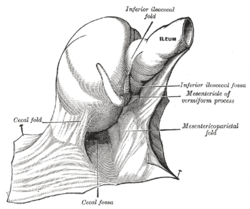Ileum
| Ileum | |
|---|---|

Small intestine
|
|

The cecal fossa. The ileum and cecum are drawn backward and upward.
|
|
| Details | |
| Precursor | midgut |
| Artery | ileal arteries |
| Vein | ileal veins |
| Nerve | celiac ganglia, vagus |
| Identifiers | |
| Latin | Ileum |
| TA | A05.6.04.001 |
| FMA | 7208 |
|
Anatomical terminology
[]
|
|
The ileum /ˈɪliəm/ is the final section of the small intestine in most higher vertebrates, including mammals, reptiles, and birds. In fish, the divisions of the small intestine are not as clear and the terms posterior intestine or distal intestine may be used instead of ileum.
The ileum follows the duodenum and jejunum and is separated from the cecum by the ileocecal valve (ICV). In humans, the ileum is about 2–4 m long, and the pH is usually between 7 and 8 (neutral or slightly alkaline).
Ileum is derived from the Greek word eilein, meaning "to twist up tightly."
The ileum is the third and final part of the small intestine. It follows the jejunum and ends at the ileocecal junction, where the ileum communicates with the cecum of the large intestine through the ileocecal valve. The ileum, along with the jejunum, is suspended inside the mesentery, a peritoneal formation that carries the blood vessels supplying them (the superior mesenteric artery and vein), lymphatic vessels and nerve fibers.
There is no line of demarcation between the jejunum and the ileum. There are, however, subtle differences between the two:
The four layers that make up the wall of the ileum are consistent with those of the gastrointestinal tract. From the inner to the outer surface, these are:
...
Wikipedia
